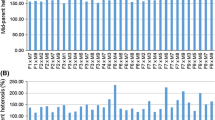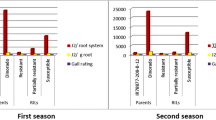Abstract
Nematodes cause substantial grain yield loss in susceptible maize (Zea mays L.) cultivars. This study was conducted to estimate general combining ability (GCA), specific combining ability (SCA) and genetic effects associated with nematode resistance in maize. The 30 F 1 hybrids generated from a 6 × 6 diallel and two local checks were evaluated in 2009 at three sites in Uganda. A split plot design was used with nematode treatments serving as whole plots and the hybrids as subplots but arranged in an 8 × 4 spatially adjusted alpha-lattice design. The experiment was replicated three times. Results showed GCA to be important for the reduction of P. zeae and Meloidogyne spp. densities and increase of root mass, with a contribution of 72 to 93% of the phenotypic variance. Inbreds MP709 and CML206 had the highest GCA for Pratylenchus zeae resistance, whereas for grain yield, it was CML444, CML312 and CML395 that were outstanding. The SCA influenced plant height and grain yield under nematode infestation, contributing 43 and 58% of the phenotypic variance, respectively. Observed reciprocal differences due to maternal effects also played a role in influencing the grain yield under nematode infestation. Overdominance genetic effects explained the non-additive variance recorded for the plant height, grain yield, number of root lesions, and P. zeae and Meloidogyne spp. densities under nematode infestation. The parents MP709, CML206, 5057, and CML444 contributed most of the dominant genes for the P. zeae resistance in all their crosses. The parent CML444 contributed most of the dominant genes for improved grain yield in all of its crosses. The high GCA effects among some parents support their utility in breeding of widely adapted nematode-resistant cultivars. The dominant genes and SCA effects would favour pedigree and various sib tests to improve grain yield under nematode pressure.





Similar content being viewed by others
References
Asmus GL, Ferraz LCCB, Appezalo da Gloria B (2000) Anatomical changes in corn (Zea mays L.) roots caused by Meloidogyne javanica. Nematropica 30:33–39
Baker RJ (1978) Issues in diallel analysis. Crop Sci 18:533–536
Betrán FJ, Hallauer AR (1996) Characterisation of interpopulation genetic variability in three hybrid maize populations. J Hered 87:319–328
Betrán FJ, Ribaut JM, Beck D, Gonzalez D (2003) Genetic diversity, specific combining ability, and heterosis in tropical maize under stress and nonstress environments. Crop Sci 43:797–806
Bridge J (1994) Priorities in plant nematology, a national and regional review. In: Sutherland JA (ed) Crop protection and the Kenya smallholder farmer. National Agricultural Research laboratories, Nairobi, pp 22–24
CIMMYT (1985) Managing trials and reporting data for CIMMYT International Maize Testing Program. CIMMYT, Mexico D.F., p 20
Coyne DL, Kagoda F, Wambugu E, Ragama P (2006) Response of cassava to nematicide application and plant-parasitic nematode infection in East Africa, with emphasis on root knot nematodes. Int J Pest Manage 52:215–223
Coyne DL, Nicol JM, Claudius-Cole B (2007) ‘Practical Plant NematologyA Field and Laboratoty Guide’. SP-IPM Secretariat: International Institute of Tropical Agriculture (IITA), Cotonou, p 82
Derera J, Tongoona P, Vivek BS, Laing MD (2007) Gene action controlling grain yield and secondary traits in Southern African maize hybrids under drought and non-drought environments. Euphytica 162:411–422
Egunjobi OA, Bolaji EI (1979) Dry season survival of Pratylenchus spp in maize fields in Western Nigeria. Nematol Medit 7:129–135
Falconer DS (1981) Introduction to Quantitative Genetics. Longman, New York
Forrest JMS, Holliday JM (1979) Screening for quantitative resistance to the white potato cyst nematode (Globodera pallida). Ann Appl Biol 91:371–374
Hayman BI (1954) Theory and analysis of diallel crosses. Genetics 39:789–809
Hayman BI (1957) Interaction, heterosis and diallel cross. Genetics 42:336–355
Jinks JL (1954) The analysis of continuous variation in a diallel cross of Nicotiana rustica varieties. Genetics 39:767–788
Jinks JL, Hayman BI (1953) The analysis of diallel crosses. Maize Genet Coop News 27:48–54
Johnson AW, Sumner DR, Windham GL, Williams WP (1999) Effects of a resistant corn hybrid and Fenamiphos on Meloidogyne incognita in a corn-squash rotation. J Nematol 31:184–190
Jordaan EM, De Waele D (1987) Resistance of maize to plant parasitic nematodes: a literature review. In: Jordaan EM, De WaeleD (eds) Proceedings of the Seventh South African maize breeding symposium, 1986. Pretoria, Department of Agriculture and Water Supply, pp 60–66
Jordaan EM, De Waele D, Van Rooyen PJ (1989) Endoparasitic nematodes in maize roots in the Western Transvaal as related to soil texture and rainfall. J Nematol 21:356–360
Kagoda F, Derera J, Tongoona P, Coyne DL (2010) Awareness of plant-parasitic nematodes and maize varietal preferences by smallholder farmers in East and Southern Uganda: a basis for assessing maize nematode resistance breeding needs in Africa. Int J Pest Manage 56:217–222
Kearsey MJ, Pooni S (1996) The genetic analysis of quantitative traits. Chapman and Hall, London, p 381
Keetch DP (1989) A perspective of plant nematology in South Africa. S Afr J Sci 85:506–508
Kiekens R, Vercauteren A, Moerkerke B, Goetghebeur E, Daele H, Sterken R, Kuiper Martin, Eeuwijk F, Vuylsteke M (2006) Genome-wide screening for cis-regulatory variation using a classical diallel crossing scheme. Nucleic Acids Res 34:3677–3686
Kimenju JW, Waudo SW, Mwang’ombe AW, Sikora RA, Schuster RP (1998) Distribution of lesion nematodes associated with maize in Kenya and susceptibility of maize cultivars to Pratylenchus zeae. Afr Crop Sci J 6:367–375
Lordello AIL, Lordello RRA (1992) Maize genotypes indicated for planting in areas infested with Meloidogyne javanica. Agronomico 44:21–22
Magorokosho C, Vivek B, Bänziger M, MacRobert J (2007) Characterization of maize germplasm grown in eastern and southern Africa: Results of the 2006 regional trials coordinated by CIMMYT. CIMMYT, Harare, p 58
McDonald AH, Nicol JM (2005) Nematode parasites of cereals. In: Luc M, Sikora RA, Bridge J (eds) Plant-parasitic nematodes in subtropical and tropical agriculture. CABI Publishing, Egham, UK, pp 131–191
NARO (2002) Addressing the challenges of poverty eradication and modernisation of agriculture. In: Otim-Nape GW (ed) Improved Technologies by NARO, 1192–2002. National Agricultural Research Organisation, p 66
Nawar AA, Fahmi AI, Salama SA (1997) Genetic analysis of yield components and callus growth characters in maize (Zea mays L.). J Genet Breed 53:119–127
Norton DS, Edwards J, Hinz PN (1985) Nematode populations in maize and related species. Maydica 30:67–74
Olowe T (1977) Histological changes in maize root induced by Pratylenchus brachyurus and P. zeae in the absence of other micro-organisms. Nigeria J Plant Prot 3:41–51
Olowe T, Corbett DCM (1976) Aspects of the biology of Pratylenchus brachyurus and P. zeae. Nematologica 22:202–211
Oyekanmi EO, Coyne DL, Fawole B (2007) Screening of selected microorganisms and maize genotypes for Pratylenchus zeae management and improved yield of Zea mays L. Master of Philosophy Thesis, University of Ibadan, p 135
Payne RW, Murray DA, Harding SA, Baird DB, Soutar DM (2009) Genstat for windows (12th edition) introduction Software. VSN International, Hemel Hemstead, p 146
Pratt R, Gordon S, Lipps P, Asea G, Bigirwa G, Pixley K (2003) Use of IPM in the control of multiple diseases in maize: strategies for selection of host resistance. Afr Crop Sci J 11:189–198
Rani CI, Veerargavathatham D, Prabhu M (2009) Heterosis studies in tomato (Lycopersicon esculentum Mill.) hybrids for root and biochemical characters for root knot nematode resistance. Adv Environ Biol 3:120–124
Rasmann S, Kollner TG, Degenhardt J, Hiltpold I, Toepfer S, Kuhlmann U, Gershenzon J, Turlings TCJ (2005) Recruitment of entomopathogenic nematodes by insect-damaged maize roots. Nature 434:732–737
Rhoades HL (1979) Evaluation of nematicides and methods of their application for control of nematodes on field corn. Nematropica 9:43–47
Sawazaki E, Lordello AIL, Lordello RRA (1987) Inheritance of corn resistance to Pratylenchus spp. Bragantia 46:27–33
Sibiya J (2009) Breeding investigations for resistance to Phaeosphaeria leaf spot (PLS) and other important foliar diseases and a study of yield stability in African maize germplasm. PhD Thesis, University of KwaZulu-Natal, p 249
Stuber CW (1994) Heterosis in plant breeding. Plant Breed Rev 12:227–251
Talwana HL, Butseya MM, Tusime G (2008) Occurrence of plant parasitic nematodes and factors that enhance population build-up in cereal-based cropping systems in Uganda. Afr Crop Sci J 16:119–131
Taylor SP, Vanstone VA, Ware AH, McKay AC, Szot D, Russ MH (1999) Measuring yield loss in cereals caused by root lesion nematodes (Pratylenchus neglectus and P. thornei) with and without nematicide. Aust J Agric Res 50:617–622
Todd TC, Oakley TR (1996) Seasonal dynamics and yield relationships of Pratylenchus spp. in corn roots . Suppl J Nematol 28:676–681
Trudgill DL (1991) Resistance to and tolerance of plant-parasitic nematodes in plants. Ann Rev Phytopathol 29:167–192
Williams WP, Windham GL (1992) Reaction of diallel cross of maize to Meloidogyne incognita under field conditions. Field Crops Res 30:167–171
Windham GL, Williams WP (1988) Resistance of maize inbreds to Meloidogyne incognita and M. arenaria. Plant Dis Rep 72:67–69
Wolf DP, Hallauer AR (1997) Triple testcross analysis to detect epistasis in maize. Crop Sci 37:763–770
Wolf DP, Peternelli LA, Hallauer AR (2000) Estimate of genetic variance in an F2 maize population. J Hered 91:384–391
Zhang Y, Kang MS, Lamkey KR (2005) Diallel-SAS05: A comprehensive program for Griffing’s and Gardner-Eberhart analyses. Agron J 97:1097–1106
Zhang JF, Waddell C, Sengupta-Gopalan C, Potenza C, Cantrell RG (2007) Diallel analysis of root-knot nematode resistance based on galling index in upland cotton. Plant Breed 126:164–168
Zsuzsanna Z, Zsuzsanna GH, Otto I, Istvan P, Ferenc R, Csaba S (2002) Inheritance of plant and ear height in maize (Zea mays L.), pp 1–5. www.date.hu/acta-agraria/2002-08i/zsubori.pdf
Zwart RS, Thompson JP, Godwin ID (2004) Genetic analysis of resistance to root-lesion nematode (Pratylenchus thornei) in wheat. Plant Breed 123:209–212
Acknowledgments
We gratefully acknowledge the support given by the Nematology staff at the International Institute of Tropical Agriculture (IITA), Uganda, during the course of the study. Great appreciation goes to the Bufulubi Prison Farm Management and Makerere University Kabanyolo Research Farm, which allocated land for field evaluation trials. Germplasm for the study was provided by IITA-Nigeria, CIMMYT, the Cereals Programme at Namulonge and the USDA–ARI Corn Host Plant Resistance Research Unit, Mississippi State. Funds for the study were offered by the Alliance for a Green Revolution in Africa (AGRA). Many thanks go to the entire staff of the African Centre for Crop Improvement (ACCI), led by Prof. Mark Laing, for their logistical support.
Author information
Authors and Affiliations
Corresponding author
Rights and permissions
About this article
Cite this article
Kagoda, F., Derera, J., Tongoona, P. et al. Genetic analysis of resistance to nematodes in inbred maize (Zea mays L.) and maize hybrids. Euphytica 182, 377–393 (2011). https://doi.org/10.1007/s10681-011-0512-0
Received:
Accepted:
Published:
Issue Date:
DOI: https://doi.org/10.1007/s10681-011-0512-0




